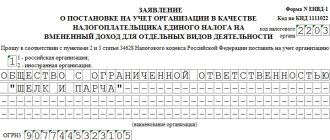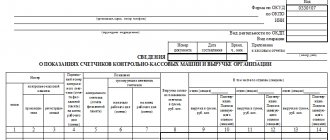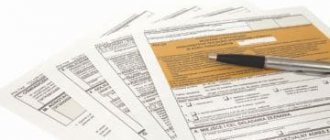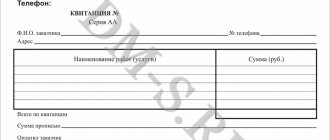Report on changes in capital, Form 3 is one of the types of annual reporting that almost all Russian organizations are required to submit to the Tax Inspectorate. But the deadline for submission in 2021 has changed.
IMPORTANT!
In connection with the announcement of April as a non-working month by Presidential Decrees and taking into account the norms approved by Decree of the Government of the Russian Federation of July 10, 2019 No. 875, the first closest working day became May 6. This day in 2021 is the deadline for submitting financial statements.
Composition and structure of the report
The document is divided into 3 parts, each of which has a tabular form. Despite the fact that there are established sample forms for reporting, an enterprise can independently edit the document until it obtains the desired form. Nevertheless, it must consistently contain information by section:
- I – “Movement of capital”.
- II – “Adjustments due to changes in accounting policies and corrections of errors.”
- III – “Net assets”.
The contents of the statement of changes in capital fully reflect events occurring with the enterprise's own sources. The first section is devoted to the capital structure and transactions carried out with it. The second consists of at least three, and if it is necessary to reflect changes in other items of capital, then more parts. The third section contains information on the values at the end and beginning of the period of net assets. The statement of changes in capital (Form 3) must be drawn up on the basis of data for 3 years: the reporting year and the two preceding it.
Who submits reports and when?
Let's figure out who submits the report on changes in capital in 2021. Reporting in Form No. 3 is provided annually by large and medium-sized enterprises, the organizational structure of which consists of the authorized shares of the founders and their own shares. Institutions operating under a simplified taxation system, representatives of small businesses, and non-profit organizations do not submit the form under OKUD number 0710004.
Form No. 3 is submitted to the territorial offices of the Federal Tax Service and statistical departments within three months after the end of the reporting period, that is, until March 31 inclusive.
IMPORTANT!
To provide information to the Federal Tax Service, the format approved by the Ministry of Finance is rarely used. The Tax Inspectorate recommends the specialized KND form 0710099, which was approved in letter dated November 25, 2019 No. VD-4-1/ [email protected]
Form No. 3 is allowed to be submitted both in paper and electronic form through specialized communication channels. The filing procedure in 2021 will remain the same; no news or changes are expected on this issue.
Requirements for the content of the report
The report on changes in capital (Form 3) must be prepared in accordance with the requirements of the Ministry of Finance of the Russian Federation. The contents indicate:
- net profit and loss values;
- each item of profit/loss, income/expenses in monetary terms and their amount;
- the effect of the accumulation of changes in accounting policies and the adjustment of errors considered in accordance with IFRS;
- capital transactions;
- changes in additional and reserve capital, as well as the condition and value of the company’s shares.
The data must be presented in the report itself or in an appendix to it. If you comply with the rules for maintaining accounting and financial records, it is not difficult to fill out Form 3 “Report on changes in capital”, a sample form of which can be found in the recommendations of the Ministry of Finance of the Russian Federation for the preparation of mandatory financial statements.
When are Forms 3, 4 and 6 of the balance sheet prepared?
Forms 3, 4 and 6 of the balance sheet are included in the annual financial statements and are appendices to its main forms (balance sheet and income statement):
- Form 3 - statement of changes in capital;
- Form 4 - cash flow statement;
- Form 6 - report on the intended use of funds.
The application forms, as well as the main forms of accounting, are approved by Order of the Ministry of Finance of Russia “On Forms of Accounting Reports of Organizations” dated July 2, 2010 No. 66n. The same document contains a rule establishing that in a simplified version of reporting, the required forms are a balance sheet, a report on financial results and a report on the intended use of funds, and explanations for them should be drawn up only if absolutely necessary (clause 6).
IMPORTANT! When preparing reports for 2021, keep in mind that accounting forms have changed. Key differences: reporting can only be prepared in thousands of rubles; millions can no longer be used as a unit of measurement. OKVED has been replaced by OKVED 2. For other changes, see here.
Read more about existing balance sheet options in the article “Balance Sheet (Assets and Liabilities, Sections, Types).”
Since the report on the intended use of funds (Form 6) is intended for use when there is a movement of funds for a very specific purpose, it is not always used. Thus, Forms 3, 4 and 6 may not be prepared by persons reporting under the simplified form.
For information about who can use simplified reporting, read the material “Simplified reporting for small businesses” .
But the set of reports generated according to its full version will include forms 3 and 4. In this case, Form 6 and other explanations will be issued if necessary.
ConsultantPlus experts provided step-by-step instructions for filling out appendices to financial statements. Get trial access to the K+ system and proceed to the financial statements manual for 2020.
Read about the principles that serve as the basis for the formation of accounting records in the article “What requirements should accounting records satisfy?” .
Characteristics of the first part of the report
Section I of the third form contains information on all changes in the elements of the enterprise’s equity capital for the period under review. It includes: authorized, additional, reserve capital, as well as data on retained earnings (uncovered losses), shares purchased from the owners of the enterprise.
In each part, relevant indicators are indicated that can be compared with data from previous years. If the company has not changed its accounting policies, then the values will coincide with those included in the reports for the past 2 years. In case of changes, it is necessary to make adjustments to the data and indicate the reasons for the discrepancy in the explanatory note to the report.
Authorized capital: rules for filling out the column
The authorized capital of an enterprise is created upon formation of a legal entity through contributions from the founders. During the financial activities of the company, the volume of assets may change, which must be documented.
The statement of changes in capital begins with the first part “Authorized capital” of Section I. The data required to fill out is located on account 80, which is opened to account for the funds of the authorized capital. The column indicates:
- balance of initial capital as of December 31. reporting year and two previous years;
- the amounts by which capital was reduced or increased in one year.
Credit turnover on account 80 is indicated in the corresponding line of the report - increase in capital. If there are debit turnovers on the authorized capital account, fill out a column explaining the reason for its decrease. A change in the size of the authorized capital usually results from an increase or decrease in the number of shares and their par value, as well as the reorganization of the enterprise.
Own shares and shares purchased from shareholders
The data for this report item is in the balance sheet (Section III). The numerical value of own shares and shares purchased from shareholders is included in the capital and subtracted from it. Because of this, it is recommended to indicate the amount on Forms 1 and 3 using parentheses.
Shares purchased for further resale in value terms are reflected on the account. 81. The amount is the actual acquisition costs. When shares are withdrawn from circulation, the size of the authorized capital is reduced by the amount of their value. The difference between the selling price and the nominal value is included in other income/expenses of the enterprise.
Reflection of additional and reserve capital in the report
Cash as part of additional capital is accounted for in account 83. The main feature of filling out the column “Additional capital” is the reflection of indicators that affect its overall value. Moreover, the inter-reporting period from December 31 of the previous year to January 1 of the reporting year is taken as the period under consideration. This procedure is established due to the rules for revaluation of fixed assets: data received as of January 1 of the new year must be indicated as of December 31. previous year. For example, when revaluing as of 01/01/16. the date for the report will be 12/31/15.
The indicator is determined based on loan turnover data when interacting with accounts:
- accounting for cash and settlements when creating a positive exchange rate difference;
- accounting for financial results (account 91) when a negative exchange rate difference is formed;
- 75 on the amounts of the founders’ contribution to the property of the enterprise.
Accounting for reserves is kept on the account. 82. The document indicates data on the amount of deductions in the reporting and two previous periods. Reserve capital is formed from retained earnings in order to pay off expenses in cases where it is impossible to pay them from net income.
Retained earnings and uncovered losses
To reflect data on the amount of retained earnings (loss), a period is used that influences the overall value of the value. As with the additional capital indicator, the period under consideration is the period from December 31 of the year preceding the reporting year to January 1. reporting year.
The indicators that form profit (loss) include:
- cash net profit (loss);
- OS revaluation process;
- expenses and income affecting changes in the amount of capital;
- amount of dividends;
- process of reorganization of a legal entity.
Accounting statements -2020: how, where and when to submit
Accounting reporting forms 2021 must be submitted to the territorial body of Rosstat at the location of the organization and its branches, if they maintain separate accounting and have the appropriate status, as well as to the Federal Tax Service inspection at the place of registration of the taxpayer.
The set of documents for these two bodies is the same. Those organizations that are required by law to undergo an annual audit must submit an audit report along with their balance sheet. Although, by law, they have until December 31, 2021 to do this, it is better not to delay. After all, Article 18 of the Federal Law of December 6, 2011 No. 402-FZ defines the obligation of a legal entity to send audit documents to Rosstat within 10 working days from the day following the end date.
Characteristics of the values of some report lines
Income and expenses that are directly related to an increase (decrease) in capital are not included in the financial result of the enterprise. Their value is attributed in the case of income to line 3213 (3313), and in the case of expenses - to line 3223 (3323) of the statement of changes in capital.
The values of the capital reduction lines are indicated in parentheses, since the values change the capital downwards. Line 3227 (3327) contains information about the amount of profit that was distributed among the founders.
After the data in the first section has been successfully entered into the document, it is necessary to calculate the sum of all values. It is worth considering that the value in brackets must be subtracted from the result. The total values must coincide with the data indicated in the balance sheet (Section III).
Form 4 balance sheet
A Form 4 balance sheet is the common name for the cash flow statement. It contains information about the organization's cash flows for the reporting and previous years. Cash flows are detailed in the context of current, investment and financial transactions. For each type of activity, the receipt and expenditure of funds are shown.
At the same time, current operations include operations related to the implementation of ordinary activities. For example, receipts include sales proceeds and rental payments, while payments include payments to suppliers and wages. Investment transactions are those related to the acquisition, creation or disposal of non-current assets.
As cash flows from financial transactions, flows from operations related to attracting financing on a debt or equity basis, leading to a change in the size and structure of the capital and borrowed funds of the organization (credits, borrowings, deposits, etc.) are classified.
The procedure for filling out the report is described in detail in PBU 23/2011 “Cash Flow Report” (approved by Order of the Ministry of Finance of the Russian Federation dated 02.02.2011 No. 11n).
You can also download the form on our website using the link below:
A sample of filling out a cash flow statement was prepared by ConsultantPlus experts. Get trial access to the K+ system and download the document for free:
Completing Section I of the report on changes in capital
Each of the section articles to be filled out has its own code. Let's look at an example of filling out the first section without indicating the amounts, considering the reporting year to be 2015. First, the data is grouped into subsections:
- code 3100 “Capital amount as of 12/31/13”;
- code 3200 “Capital amount as of 12/31/14”;
- code 3300 “Capital amount as of 12/31/15.”
Each of them (except 3100) contains the following information:
1. Code 3210, 3310 “Increase in capital, total”, including:
- 3211, 3311 “Net profit”;
- 3212, 3312 “Revaluation of fixed assets and intangible assets”;
- 3213, 3313 “Income that is directly attributable to an increase in capital”;
- 3214, 3314 “Additional issue of shares”;
- 3215, 3315 “Increase in par value of shares”;
- 3216, 3316 “Reorganization of legal entities. faces."
2. Code 3220, 3320 “Reduction of capital”, including:
- 3221, 3321 “Loss”;
- 3222, 3322 “Revaluation of fixed assets and intangible assets”;
- 3223, 3323 “Expenses directly related to the reduction of capital”;
- 3224, 3324 “Reduction in par value of shares”;
- 3225, 3325 “Reduction in the number of shares”;
- 3226, 3326 “Reorganization of legal entities. faces";
- 3227, 3327 "Dividends".
3. Code 3230, 3330 “Additional capital”.
4. Code 3240, 3340 “Reserve capital”.
The table contains information without a column about the title of the article: only the code is used.
When preparing reports, you must fill out all 8 columns. Section I “Changes in capital”
| Code | Authorized capital | Own shares purchased from owners | Extra capital | Reserve capital | Retained earnings (loss) | Total |
| 3100 | () | |||||
| 3200 | () | |||||
| 3210 | ||||||
| 3211 | — | — | — | — | About (Kt) account. 84 with account 99 | |
| 3212 | — | — | Sk (Kt) count. 83 | — | ||
| 3213 | — | — | About (Kt) account. 83 | — | ||
| 3214 | About (Kt) account. 80 from account 75 | About (Kt) account. 81 in correspondence with account. 75, 91 | About (Kt) account. 83 in correspondence with account. 19, 75 | — | — | |
| 3215 | About (Kt) account. 80 from account 75 | About (Kt) account. 83 in correspondence with account. 19, 75 | — | — | ||
| 3216 | ||||||
| 3220 | () | () | () | () | () | |
| 3221 | — | — | — | — | About (Dt) count. 84 with account 99. Meaning in "()" | () |
| 3222 | — | — | () | — | () | () |
| 3223 | — | — | () | — | () | () |
| 3224 | About (Dt) count. 80 from account 75. Meaning in "()" | About (Dt) count. 83 with account 75, value in "()". Or Ob (Kt) account. 83 in correspondence with account. 80 | — | () | ||
| 3225 | About (Dt) count. 80 from account 81, value in "()" | Total turnover by account. 81 (if the amount Ob (Dt) › the amount Ob (Kt), then the value is in “()”) | — | () | ||
| 3226 | () | |||||
| 3227 | — | — | — | — | About (Dt) according to count. 84 with account 75, 70, value in "()" | () |
| 3230 | — | — | About (Dt) count. 83 in correspondence with account. 84 | About (Kt) account. 82 with account 83 | About (Kt) account. 84 with account 83 | — |
| 3240 | — | — | — | — |
In brackets are the values that are subtracted during the calculation, and a dash means an empty column. The table shows an example of filling out the first section of the statement of changes in equity without indicating the amounts of data.
The lines of subgroup 3300 are filled in similarly to 3200. After filling in for each column, the final value is displayed, which is indicated in the lines of subgroups 3210 and 3220, and then in the general characteristics of capital for the year (line 3100, 3200). In order to determine the value of the “Total” column, you need to add all the data in each column in the row.
Section II – adjustments and error corrections
As in the first section, the data indicate for the reporting period and the two years preceding it. Drawing up a statement of changes in capital using this document is mandatory only in cases where changes were made to the enterprise's accounting policies during the reporting period or serious errors from previous years were corrected.
The report is compiled in the form of a table indicating the names of indicators, their codes and values for the 3 periods under review. The document is compiled using the following algorithm:
- Enter the amount of capital before adjustment on line 3400.
- In line 3410 reflect the adjustment values due to changes in the enterprise's accounting policies.
- In line 3420, reflect the value of the adjustment due to error corrections.
- In the required line from 3401-3502, indicate in detail the reason why the capital item is being adjusted.
The second and third points of the algorithm are carried out depending on the necessary actions: adjustments are made due to correction of errors or changes in the organization’s accounting policies.
Report Definition
The form indicates three different characteristics:
- What type of capital do you have - additional, authorized, etc.
- Changes affecting capital - whether it decreased or, conversely, increased
- How exactly has capital changed over the past three years?
What is the main purpose of compiling such a report? The main thing here is to show how and in what way the financial condition of the company has changed over a certain period of time.
Due to the fact that the report reflects what changes in capital occurred in a specific period, based on these data it is possible to analyze changes in the financial organization in general and in particular. As a result, financiers can conclude what influenced the increase and decrease in capital.
Statement of Changes in Capital: Section III
The form of the third part of the report contains information on the net assets of enterprises for the 3 periods under review. Net assets are the sum of the value of non-current and current assets that are secured by equity capital. The value of the net assets of JSCs and LLCs is calculated according to the order of the Ministry of Finance of the Russian Federation.
Accounting is the main source of data for calculating net assets. Values for calculations are taken from the balance sheet (Form 1). The net assets formula looks like this: Account.a. = A – Ob – Z, where:
- A – assets that are taken into account (current and non-current assets, section I-II of the balance sheet);
- About – the amount of liabilities that are accepted for calculation (excluding future income on a gratuitous basis or in the form of government assistance);
- Z – debt of shareholders in terms of contributions to the authorized capital.
For a JSC or LLC, it is extremely important to monitor the net asset indicator: it will always be equal to or greater than the authorized capital. If the condition is not met, it is necessary to take measures to comply with it: reduce the amount of own funds contributed by the founders.
Who submits simplified financial statements
The Law “On Accounting” dated December 6, 2011 No. 402-FZ provides for some organizations the right to use simplified methods of accounting, as well as to prepare simplified financial statements. In paragraph 4 of Art. 6 of this law lists the following subjects:
- organizations classified as small in terms of business volume;
- non-profit structures created in accordance with the Law “On Non-Profit Organizations” dated January 12, 1996 No. 7-FZ;
- participants of the Skolkovo project, subject to the Law “On Innovation dated September 28, 2010 No. 244-FZ.
To determine whether an organization is classified as small, you need to correlate its indicators with the requirements of the law “On the development of small and medium-sized businesses in the Russian Federation” dated July 24, 2007 No. 209-FZ.
About the criteria that must be met in order to call an organization a small enterprise, read the article “Small enterprise - designation criteria” .
In addition, those wishing to simplify their accounting should check whether they are subject to the restrictions established by clause 5 of Art. 6 of Law No. 402-FZ. This clause prohibits the use of simplified accounting and reporting, for example, by government organizations, entities subject to mandatory audit, and some legal structures.
Preparation of a statement of changes in capital in 2021
There have been no amendments to the preparation of financial statements for 2021. Form No. 3 still consists of four parts: a title and three sections.
The title must contain basic information about the company:
- Name;
- OKPO, INN;
- organizational and legal type of organization, OKOPF code;
- OKVED;
- reporting year and date of filling out documents;
- form of ownership and OKFS code;
- indicating the rounding code for amounts to thousands of rubles (384) or millions (385).
Most of the title page is designed similarly to other forms of reporting.
Data must be indicated sequentially for each year (from the third to the reporting year), negative values must be enclosed in parentheses. Fill in empty fields with a dash. The last date for submission of the annual report for 2015 is 03/31/16.
In what form are simplified reports submitted to the Federal Tax Service?
All economic entities preparing financial statements must submit their annual version to the tax office by virtue of subclause. 5 p. 1 art. 23 Tax Code of the Russian Federation. The Code does not oblige the submission of a report in electronic or paper form; the organization can make this choice independently. The Ministry of Finance of the Russian Federation once again recalled this in letter dated February 13, 2018 No. 03-02-07/1/8624.
However, at present, programs for sending electronic reporting are becoming increasingly widespread in connection with the requirements of tax legislation on the use of electronic forms for submitting tax reports for organizations with more than 100 people, as well as for all entities reporting VAT. In this regard, the Federal Tax Service has developed a special format for simplified accounting reporting KND 0710096, the latest (current) version of which was approved by order dated July 16, 2018 No. PA-4-6/ [email protected] (see letter of the Federal Tax Service dated July 16, 2018 No. PA-4- 6/ [email protected] ).
For information on existing methods of submitting reports via the Internet, read the article “Procedure for submitting tax reports via the Internet” .
Financial analysis of the statement of changes in equity
A qualitative analysis of annual reporting, in particular Form 3, allows you to assess the development of the enterprise over time and develop further goals for financial activities. The results of data systematization may indicate the near future of the organization: bankruptcy or increased profits. By considering the indicators of the statement of changes in capital, a specialist is able to identify strengths and weaknesses, thereby providing management with the opportunity to regulate the policies of their own business on favorable terms.
The nature of the reporting analysis depends on the purpose, which can be simply monitoring data or determining liquidity, creditworthiness, solvency and other indicators of the enterprise’s performance. The corresponding coefficients are used for calculations.
The main indicators of the company's capital flow are the coefficient of inflow and outflow of funds, which are determined by the formulas: Kp = P ÷ Sk.g., Kv = B ÷ Sg.g.. The inflow coefficient is calculated as the ratio of the amount of incoming capital to the balance at the end of the year, and disposal ratio - as the sum of disposed funds to the balance at the beginning of the year. If the entry ratio exceeds the exit ratio, then the enterprise's own capital is enriched. The rule also applies in the opposite direction.
The statement of changes in equity is part of the statutory financial statements, which consists of four forms. Entries are made only on the basis of accounting data. The bulk of the information is transferred from the balance sheet. After calculating the totals of Form 3, it is necessary to check their agreement with the data of Form 1.
Form 6 balance sheet
The sixth form of balance sheet is a report on the intended use of funds, which is compiled by non-profit organizations (NPOs) and legal entities receiving any targeted funding.
For NPOs, this report is essentially the main one. In this report they disclose information about the intended use of funds received to support statutory activities. It shows the balance of targeted financing at the beginning of the reporting year, the receipt and expenditure of such funds during the reporting period and their balance at the end of the year.
Form 6, as well as the main reporting forms (balance sheet and financial results report), has 2 design options: full (Appendix 1 to Order No. 66n) and simplified (Appendix 5 to Order No. 66n). The latter may be made up of organizations that have the right to use simplified methods of accounting when preparing reports in a simplified form.
You can download both versions of Form 6 on our website using the links below:










